
This page is part of © FOTW Flags Of The World website
Neo-Nazi flag symbolism
Last modified: 2016-05-02 by randy young
Keywords: nazi | neonazi | politics | swastika | cross: swastika | cross: celtic | celtic cross | sun cross | rune: odal | werewolf | 88 | eighty eight | sun (black) |
Links: FOTW homepage |
search |
disclaimer and copyright |
write us |
mirrors
See also:
Nazist movements from different parts of the world have quite similar flags. They usually are red, white and black, that are the "Bismark colors" upon which was also based Hitler's flag. The scheme is always the same: red background, a white circle in the middle and a black symbol. As in many countries it is forbidden to use fascist or Nazist symbols, they use new symbols reminescent of swastika.
Anon.
All these are flags resembling the German flag of 1933-1945. Here's a list:
- Original Nazi German flags, some newly created in 1933 and later, according to "fascist" graphical principles (in the original meaning of that word), others more or less inherited from pre-1933 german flags. Almost all banned in 1945 till today.
- Flags of foreign (non-German) entities (national and party flags), more or less sympathetic with Hitler's and Mussolini's regimes, inspired in their symbolics, design and aesthetics. Most of them disappeared during or after WWII. [list]
- Post-war flags of political organizations somehow sympathetic with the Nazi regime and world view. Some of these flags are indeed (actual or intended) copies of types 1 and 2 above. [list]
- Mockery or "atmosphere setting" flags, loosely based on any of the above, usually used in works of fiction, theme decoration or satire. [list]
- Protest flags loosely based on 1-3 above, adding to its typical design or symbols the design or symbols of the flag or emblem of some other entity, usually to convey the accusation that the said entity is somehow comparable to Nazi regimes. Usually found in political cartoons, protest rallies, etc.; humurous or otherwise.
- Flags that somehow have the same symbols and/or design as any of 1-3 above, but which have no intentional connection with their movements. [list]
António Martins, 1 February 2003
I think these are mostly beautiful flags, though politically, I strongly oppose what they stand for.
Elias Granqvist, 24 April 2001
That's completely possible. Tyrants, with their devotion to "bread and circuses," are often masters of manipulation, including symbols. The German Nazis were absolute masters of this; if they were just another political party, their flags would be considered works of art. Indeed, the swastika itself now has a meaning that no Buddhist would put on it, it being found often in their iconography and elsewhere. (I recall maps in Japan being marked with swastikas to indicate Buddhist temples. Took me a while to get used to that!)
Al Kirsch, 25 April 2001
The texts about this symbol [the so called hurricane on the P.N.S.S. flag] illustrate quite well the interesting phenomenon of Neo-Nazi symbology worldwide: The flags, symbols, salutes, etc. are clearly influenced by Hitler and Mussolini and based on them — however the "official" explanations refer most everything except that fact. This symbol is "hurricane," then? Yeah, as much as South Africa's AWB three-legged swastika was based on the number "777," and similar explanations. I simply don't get it. If these people use symbols reminding of their ideological idols, why don't they say so? There sure don't hide their intentions in other situations… Saying "our symbol looks like a swastika out of a coincidence, as it was originally designed by my mother-in-law's cat" is being plain coward — something Neo-Nazis don't like to be called at…
António Martins, 27 July 1999
It would be inconsistent with the nationalist part of the ideology, I think. The nebulous explanations also fit in with the use of the swastika — there is no link between the ancient and the Nazis, other than the swastika itself.
Ole Andersen, 28 July 1999
It is interesting to note that most mock versions of the swastika flag feel much more "Nazi" than the flags of real Nazi-sympathetic entities, and that many of the listed sympathetic regimes of the pre-WWII era end up in quite "unsympathetic" relations with Germany (the Cutch-cross Austrians, Horthy, the Rumanian what's-his-name, etc.).
António Martins, 10 February 2003
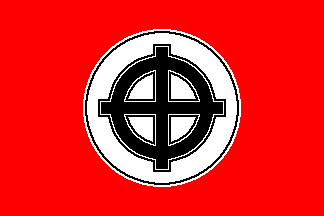
image by António Martins, 18 April 1998
(With and without the white and black lining/fimbriation, both usual forms).
António Martins, 18 April 1998
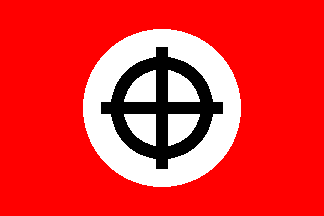
image by António Martins, 18 April 1998
The Celtic cross is probably the most popular symbol among (seemingly not only) European Neo-Nazis, even more than the traditional swastika (but that's maybe because the swastika is banned or has its use "protected" in many countries). They base it in that Celts are "true" Europeans (i.e., of "pure" breed).
António Martins, 18 April 1998
The circle/cross design has (like the swastika) a long and honourable usage before it was associated with modern Nazism. The circle/cross is another variation of the solar disk, and is found in ancient American, Asian, and European cultures. It was also associated with Celtic Christianity. The symbol also has various meanings in alchemy and hermetic studies.
Anon.
I suspect that the present users care less for the actual symbolism involved than they value its similarity to the swastika design, and substitute it for a swastika when such a design is illegal.
Anon.
The Celtic cross somehow resembles the cross on the Ku Klux Klan flag.
António Martins, 10 February 2003
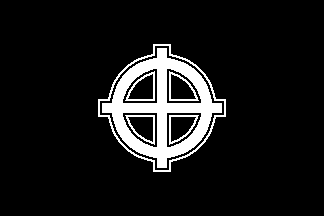
image by António Martins, 18 April 1998
This white power cross is a popular symbol amongst Europe's hardcore Nazis. It is molded after the Celtic cross, seeking to make an heritage issue of it.
António Martins, 27 May 1998, quoting Nazism Exposed | Flags and Symbols (Pål's site)
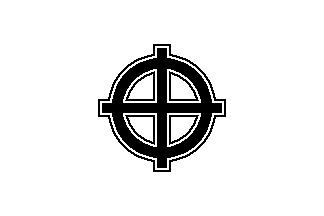
image by António Martins, 18 April 1998
Black Celtic cross on white, as opposed to the more usual white celtic cross on black, used on European Neo-Nazi flags.
António Martins, 4 October 1998
See also:
External links:
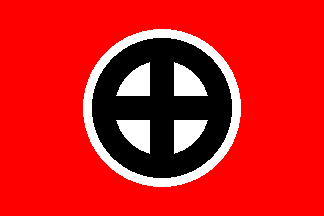
image by Tomislav Todorovic, 3 February 2007
In an episode of the TV series "Pop Music and Politics," which was broadcast on Viasat History channel several times during the year 2006, a very short interval (less than two minutes, as I estimated) was dedicated to the music of extreme right-wing rock bands, without any comments or naming of the performers (so as to show that they exist without advertising them), just illustrated with black and white photos of performances, magazines and posters. One of these photos showed the cover of a magazine named Blood and Honour, illustrated with the picture of a Neo-Nazi flag charged with a large, broad, black sun cross on a white disc. The field looked gray on the photo, which means it certainly was red.
Tomislav Todorovic, 3 February 2007
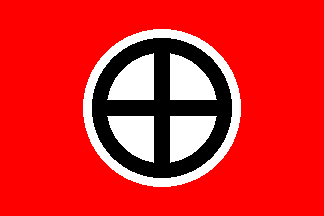
image by Tomislav Todorovic, 3 February 2007
When David Duke, former Imperial Wizard (national leader) of the Ku Klux Klan, unsuccessfully ran in the elections for the governor of Louisiana in 1991, a number of photos showing his connections with Neo-Naziism were published. One of these was published in the Serbian magazine Vreme. It showed Duke dressed as a high official of the Ku Klux Klan and sitting at a desk with a Neo-Nazi flag on the wall behind him. The flag was charged with the sun cross, narrower than the one on the flag described above. The photo was in black and white, but, just like the flag described above, the colours were obviously black (sun cross), white (disc), and red (field).
Tomislav Todorovic, 3 February 2007
See also:
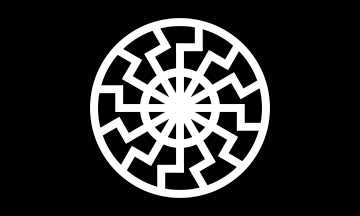
image by Tomislav Todorovic, 23 May 2015
Black Sun (German: Schwarze Sonne) is an occult symbol which is also used by some neo-Nazis. It is modeled after the central pattern of the floor mosaic in a hall of Wewelsburg Castle, Germany, where the construction of a planned cult center (never completed) for the SS forces and whole Reich, as envisaged by Heinrich Himmler, was being performed. It is not known with any certainty whether the mosaic was placed into the floor during the works in the hall (1938-1943) or was there previously, nor it is known what name, if any, the Nazis used for the symbol; its present name came into the use some time after WW2.
Flags charged with the Black Sun usually show it in white, on black field. Photos of a flag from the United Kingdom, taken in 2013, can be found here. A photo from Russia, taken in 2014, can be found here. More photos from Russia, time of making not specified, can be found here. (WARNING: This website and others like it regarding Naziism and neo-Naziism show photographs of people giving the Nazi salute.) While the Russian sources give incomplete views of the flag, still they make it possible to reveal its complete design.
Tomislav Todorovic, 23 May 2015
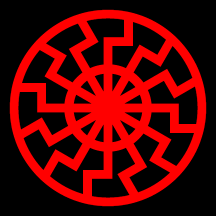
image by Tomislav Todorovic, 2 May 2016
The symbol may also appear in red color on black field. Such a flag, in square or nearly square shape, was photographed somewhere in Roussillon, France, on 24 April 2016. The symbol also seems to be larger than generally used.
Tomislav Todorovic, 2 May 2016
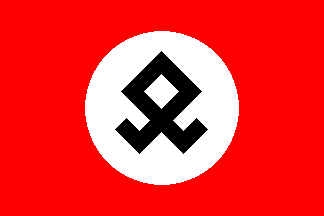
image by António Martins, 18 April 1998
Another popular rune among Neo-Nazi organizations is "ᛟ," the odal rune (notably the by the South African African Student Federation). It is the last letter of futhark, the "modern" 16-letter Viking rune set. (Here with and without the white and black lining/fimbriation, both usual forms).
António Martins, 18 April 1998
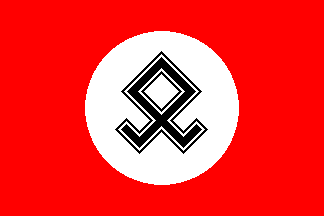
image by António Martins, 18 April 1998
The odal was originally used by ethnic Germans (Volksdeutsche) from Yugoslavia SS-regiment (the 7. SS Freiwillingen-Gebirgs — Division Prinz Eugen) operating during the WWII in the Nazi Germany-sponsored State of Croatia. According to FlagMaster 073 [flm], it may have been used by ethnic Germans in other countries.
António Martins and Mark Sensen, 18 April 1998
Another version (with arrows at the end) was used by the 23. SS-Freiwilligen-Panzer-Grenadier-Division "Nederland".
Mark Sensen, 19 April 1998
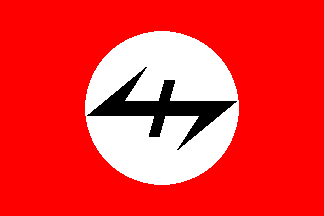
image by António Martins, 27 July 1999
I found a brief but interesting description of a symbol that appears on some current Nazist flags:
A fascist sign, used in for instance Sweden in the 1990s, meaning werewolf. According to ancient superstitions, men were sometimes transformed into beings - half men, half wolves - extremely blood-thirsty and ferocious. These beings were called werewolves. Werwolf, German for "werewolves," was the name chosen for the guerilla fighters Hitler and the Nazi top had planned should continue the fight against the invading Allies when Germany's Wehrmacht was defeated and the German territory was occupied.
Giuseppe Bottasini, 29 July 1998, quoting from www.symbols.com
A complete history of the Werwolf organization can be found at this site. The symbol was also used by a number of organizations in German-occupied Netherlands.
Marcus Wendel, 7 August 1999
This symbol is the ancient german rune Wolfsangel. In past it was a magical means to frighten away the wolves. In WWII this sign was used by Division Waffen SS Das Reich. Source: [mux97]
Viktor Lomancov, 1 January 2000
See also:
What's the connection between Neo-Nazism and "88"? It's not the first time I notice this (f.i., NZ's Unit 88). I imagine that, since "88" looks a bit like "SS" (especially if on a flag with different sides seen in backlight, hmm), and might be used as a surogate for it in the lines of what happend with the Celtic cross and other substitues for the swastika, but I'd expect to see it more prominently displayed and sported, namely on flags.
António Martins, 8 July 2002
Nothing to do with the SS, nor with the famous German 88mm gun. As far as I know, each "8" stands for the eighth letter in the (German, English, etc.) alphabet, "H." Thus "88" stands for "HH," which in turn is an abbreviation for "Heil Hitler."
Santiago Dotor, 9 July 2002
See also:
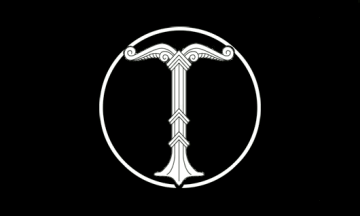
image by Tomislav Todorovic, 2 May 2016
Irminsul1 is a Germanic neo-pagan symbol which is also frequently used by the neo-Nazis. Its name probably meant "mighty pillar" in Old Saxon. The name originates from Old Saxony (roughly corresponding to present-day Lower Saxony), where it was denoting a wooden pillar, or a simple tree trunk, raised in the open air at a place of worship. While all the original objects were destroyed with the spread of Christianity and little is known about their exact appearance, modern symbol is generally based on the Externsteine relief2, a depiction of the Descent from the Cross scene which is carved into the side of the Externsteine rock formation, situated near Detmold, Germany. The scene, generally thought to be dating from 12th Century, contains a symbol which vaguely resembles a bent palm tree and is sometimes explained as such. This symbol was first described as an irminsul in 1929 by archaeologist Wilhelm Teudt, who believed that the Externsteine site was a pre-Christian place of worship centered around an irminsul and that the relief was created in order to commemorate the victory of Christianity over paganism. While no evidence for Teudt's hypothesis has ever been discovered, it caught on among the Neo-Nazis to such an extent that most of their depictions of irminsul are modeled after the symbol from Externsteine relief, although the details may vary somewhat.
A popular version of the flag with irminsul depicts the white symbol within a white ring, all on black field.3 Such a flag was photographed somewhere in Roussillon, France, on 24 April 2016.4
Sources:
1 – Irminsul at Wikipedia
2 – Externsteine relief at Wikipedia
3 – Flag with irminsul at eBay
4 – Facebook - Photo gallery of French Nationalist Party, Roussillon branch
Tomislav Todorovic, 2 May 2016












